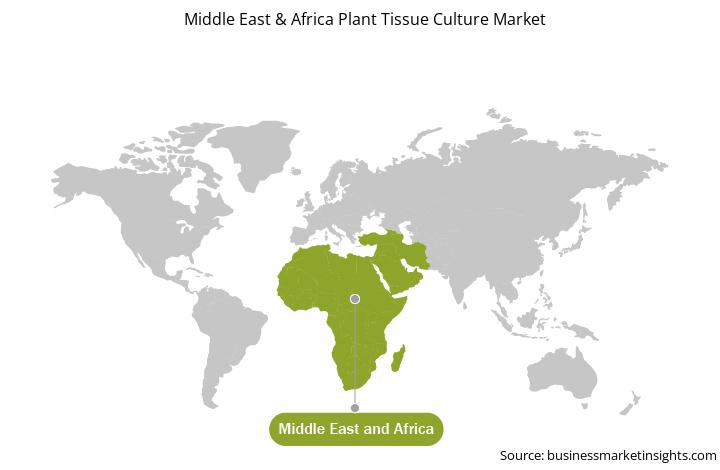Proliferation of Floriculture Bolsters Market Growth
Floriculture is a branch of ornamental horticulture concerned with growing and marketing flowers, ornamental plants, and flower arrangements. Plant tissue culture is used to develop flowers according to the need of the population. Flowers are nowadays used as a food as they contain nutraceutical and organoleptic properties. The typically high pigment concentration of the corollas (especially flavonoids and carotenoids), which have evolved to attract pollinators chromatically, indicates a marked nutraceutical activity, especially regarding antioxidant power. Edible flowers such as roses, citrus blossoms, lavender, hibiscus, and nasturtium are some of the flowers that are gaining popularity among health-conscious consumers. Edible flowers provide biologically active substances including vitamin A, C, riboflavins, niacin, minerals such as calcium, phosphorous, iron and potassium that are eventually beneficial to consumers' health. To produce flowers which provide these biologically active substances, genetic engineering and tissue culture techniques are used. Growing demand for flower as a nutritious food additive is mainly driving the growth of plant tissue culture market.
Market Overview
The Middle East & Africa plant tissue culture market is segmented into Saudi Arabia, the UAE, South Africa, and the Rest of Middle East & Africa. The growing populations in the UAE, Bahrain, Saudi Arabia, Kuwait, Qatar, and Oman can be associated with the elevated demand for crops. Major factors propelling the Middle East & Africa plant tissue culture market include rising domestic and migrant population, increasing health consciousness, changing tastes and preferences, and escalating disposable income, as these factors are encouraging the consumption of nutritional food as part of a stable diet.
Middle East & Africa Plant Tissue Culture Market Revenue and Forecast to 2028 (US$ Million)
Strategic insights for the Middle East & Africa Plant Tissue Culture provides data-driven analysis of the industry landscape, including current trends, key players, and regional nuances. These insights offer actionable recommendations, enabling readers to differentiate themselves from competitors by identifying untapped segments or developing unique value propositions. Leveraging data analytics, these insights help industry players anticipate the market shifts, whether investors, manufacturers, or other stakeholders. A future-oriented perspective is essential, helping stakeholders anticipate market shifts and position themselves for long-term success in this dynamic region. Ultimately, effective strategic insights empower readers to make informed decisions that drive profitability and achieve their business objectives within the market. The geographic scope of the Middle East & Africa Plant Tissue Culture refers to the specific areas in which a business operates and competes. Understanding local distinctions, such as diverse consumer preferences (e.g., demand for specific plug types or battery backup durations), varying economic conditions, and regulatory environments, is crucial for tailoring strategies to specific markets. Businesses can expand their reach by identifying underserved areas or adapting their offerings to meet local demands. A clear market focus allows for more effective resource allocation, targeted marketing campaigns, and better positioning against local competitors, ultimately driving growth in those targeted areas.Middle East & Africa Plant Tissue Culture Strategic Insights

Middle East & Africa Plant Tissue Culture Report Scope
Report Attribute
Details
Market size in 2022
US$ 34.79 Million
Market Size by 2028
US$ 55.08 Million
Global CAGR (2022 - 2028)
8.0%
Historical Data
2020-2021
Forecast period
2023-2028
Segments Covered
By Type
By Application
By End Users
Regions and Countries Covered
Middle East and Africa
Market leaders and key company profiles
Middle East & Africa Plant Tissue Culture Regional Insights

Middle East & Africa Plant Tissue Culture market Segmentation
The Middle East & Africa plant tissue culture market is segmented on the basis of type, application, end users, and country. Based on type, the Middle East & Africa plant tissue culture market is segmented into instrument, media & reagents, and consumables. The instrument segment held the largest market share in 2022. Further, the instrument segment is categorized into incubators, centrifuges, microscopes, sterilizers, and others. Similarly, media & reagents are categorized into murashige and skoog media, linsmaier and skoog media, and others.
Based on application, the Middle East & Africa plant tissue culture market is segmented into plant research, agriculture, forestry & technical grade, and others. The agriculture segment held the largest market share in 2022.
Based on end users, the Middle East & Africa plant tissue culture market is segmented into greenhouse, field, and laboratory. The field segment held the largest market share in 2022.
based on country, the Middle East & Africa plant tissue culture market is segmented into Saudi Arabia, South Africa, the UAE, and the Rest of Middle East & Africa. The Rest of Middle East & Africa dominated the market in 2022.
Thomas Scientific LLC; Sigma-Aldrich Co LLC; HiMedia Laboratories Pvt Ltd; Caisson Labs Inc.; Alpha Laboratories Ltd.; Becton, Dickinson and Co.; and Al-Rajhi Tissue Culture Lab are the leading companies operating in the Middle East & Africa plant tissue culture market.
The Middle East & Africa Plant Tissue Culture Market is valued at US$ 34.79 Million in 2022, it is projected to reach US$ 55.08 Million by 2028.
As per our report Middle East & Africa Plant Tissue Culture Market, the market size is valued at US$ 34.79 Million in 2022, projecting it to reach US$ 55.08 Million by 2028. This translates to a CAGR of approximately 8.0% during the forecast period.
The Middle East & Africa Plant Tissue Culture Market report typically cover these key segments-
The historic period, base year, and forecast period can vary slightly depending on the specific market research report. However, for the Middle East & Africa Plant Tissue Culture Market report:
The Middle East & Africa Plant Tissue Culture Market is populated by several key players, each contributing to its growth and innovation. Some of the major players include:
The Middle East & Africa Plant Tissue Culture Market report is valuable for diverse stakeholders, including:
Essentially, anyone involved in or considering involvement in the Middle East & Africa Plant Tissue Culture Market value chain can benefit from the information contained in a comprehensive market report.